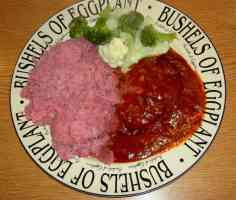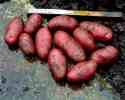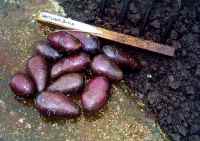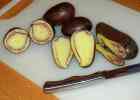|
SAVE OUR SPUDS!
by Mike Clark A new
season is upon us. At least, it should be, according to the calendar.
But if this is global warming,
please may I opt out? Excuse the mucky fingers, and the gutters between
the keys. I�ve just got the last of my tatties planted. I�m soaked to the
skin, and for once I�m not enjoying gardening.
Fitivver, tomorrow�s dinner has been invested, and all we can do now is
hope. That was the last of
nine varieties of tattie I�m growing this year, and two of them are a wee
bit hard to get. But I reckon taste and texture are worth far more than
uniformity and keep-ability. Which is why I still grow tatties the
supermarkets love to hate.
Can I just give you a wee feel of a couple of tatties which our
forefathers grew, for their flavour and texture, and which our
supermarkets will never stock because they don�t fit the cardboard
(tasting) cutout?
|

Highland Burgundy Red
Mashed With Butter and Cream |
I�ve witnessed many a raised
eyebrow when I�ve shoved a bowl of pink mash on the table. Even though
my guests are mostly producers of their own spuds, they generally
stick to the same reliable varieties. The gardener who will try a
different tomato variety every year, and experiment with new salad
leaves, rarely deviates from the favourite tattie. Maybe it�s bred
into us. The potato is a staple, and a good store of them sees us
through the long cold winter days. Reliability in cropping and in
storing is perhaps paramount.
Well, I�m not afraid to live
dangerously. I like to try a different tattie, and risk the pests,
diseases and the potential famine. |
It�s not just the reckless streak
in me. It�s a craving for flavour and texture � yes, and even colour. And
it�s also a desire to maintain varieties that are in danger of being lost
in the relentless pursuit of disease-resistance, bulk and uniformity.
And so it was that two years ago I bought some micro propagated plants of
two old, and increasingly rare, varieties. I nurtured them carefully in
pots for their first season, expecting constant attacks of aphids and
other pests. But they grew happily and healthily, and not only produced
enough reasonably sized tubers for seed, but even a few big enough to be
worth a taste. So the next
season, I had a good crop of both.
Highland Burgundy Red
 Highland
Burgundy Reds are as colourful as they sound. They are an early maincrop
variety, and I�ve found them to be as good at the start of their season as
they are at the end. I tried the first of them around the same time as I
was enjoying my early Duke of Yorks (one of my staples!), and they tasted
lovely as a �new potato�. I had the last of them from store at the
beginning of February, and they hadn�t deteriorated one bit. I�m sure they
would have stored longer, if I hadn�t been so greedy. Highland
Burgundy Reds are as colourful as they sound. They are an early maincrop
variety, and I�ve found them to be as good at the start of their season as
they are at the end. I tried the first of them around the same time as I
was enjoying my early Duke of Yorks (one of my staples!), and they tasted
lovely as a �new potato�. I had the last of them from store at the
beginning of February, and they hadn�t deteriorated one bit. I�m sure they
would have stored longer, if I hadn�t been so greedy.  As
the name suggests, they have a rather spectacular burgundy-red flesh, with
a very narrow white band. Unusually, they keep their colour very well on
cooking. When mature, they have a dry, rather fluffy texture, and the
flavour is mild and slightly sweet. On the plate, they have the appearance
of mildly anaemic beetroot, and never fail to cause a comment!
Cultivation presented few problems, though the haulms tended to sprawl.
I�ll give them a little more space this year. They suffered a little slug
damage, but nothing too serious. They are reputed to be susceptible to
blight, but mine did not fall victim. As
the name suggests, they have a rather spectacular burgundy-red flesh, with
a very narrow white band. Unusually, they keep their colour very well on
cooking. When mature, they have a dry, rather fluffy texture, and the
flavour is mild and slightly sweet. On the plate, they have the appearance
of mildly anaemic beetroot, and never fail to cause a comment!
Cultivation presented few problems, though the haulms tended to sprawl.
I�ll give them a little more space this year. They suffered a little slug
damage, but nothing too serious. They are reputed to be susceptible to
blight, but mine did not fall victim.
This is a very old variety, the origin of which is lost in the mists of
time. Rarely found in seed catalogues, it tends to be listed as �old�, or
�date unknown�! Shetland
Black
 I
would have to describe Shetland Blacks as tasty but tricky � tricky in the
kitchen, anyway, if not in the garden. They are also an early maincrop,
but though they too stored well, I�d say they were better used young. They
came into their own when the usual earlies were past that �new potato�
flavour, and at that stage it was just like tasting the first new tatties
of the season all over again. Using them from store after the turn of the
year, I found the flavour somewhat missing. I
would have to describe Shetland Blacks as tasty but tricky � tricky in the
kitchen, anyway, if not in the garden. They are also an early maincrop,
but though they too stored well, I�d say they were better used young. They
came into their own when the usual earlies were past that �new potato�
flavour, and at that stage it was just like tasting the first new tatties
of the season all over again. Using them from store after the turn of the
year, I found the flavour somewhat missing.  However,
I�ll continue to grow them and use them as they are ready, because at that
stage they are sweet and firm, becoming floury as they mature. They have a
blue-black skin, and a similar dark ring inside. Unfortunately, this fades
to dark grey when cooked, but still adds some colourful interest to a
meal. The tubers tended to be small, but fairly uniform in size, and so
were ideal for boiling whole. They are inclined to disintegrate all of a
sudden when cooking, so you need to set aside your glass of wine and keep
a constant eye on them. However,
I�ll continue to grow them and use them as they are ready, because at that
stage they are sweet and firm, becoming floury as they mature. They have a
blue-black skin, and a similar dark ring inside. Unfortunately, this fades
to dark grey when cooked, but still adds some colourful interest to a
meal. The tubers tended to be small, but fairly uniform in size, and so
were ideal for boiling whole. They are inclined to disintegrate all of a
sudden when cooking, so you need to set aside your glass of wine and keep
a constant eye on them. I had
no cultivation problems with these either. The haulms are short and quite
sparse, blight was not an issue, and though there was some slug damage it
was only minor. One thing I did note was that they seemed very shallow
rooted. This, combined with the short foliage, may make them suitable for
growing in pots. Shetland
Black is reckoned by some to date from 1923, but my research shows SB in
production in the 1880�s or even earlier.
Micro propagated plants are available now for several varieties which have
almost disappeared from cultivation. I, for one, am glad they are becoming
available again. When you�ve experienced the taste and texture of some of
these forgotten gems, you realise how bland potatoes have become.
The Organic Gardening Catalogue and Thompson & Morgan list several, and
others I�m now tempted to try are Witchhill, a first early from 1881, and
Skerry Blue, an Irish variety from 1846.
Have a go yourself. Your taste buds will thank you for it!
� Mike Clark 2005. |